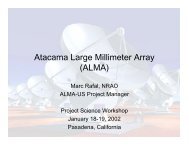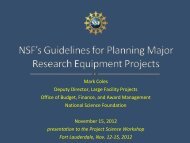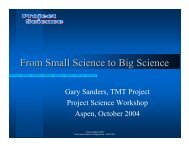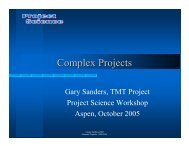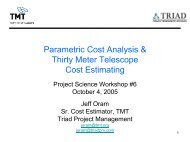Selected Details in Project Management
Selected Details in Project Management
Selected Details in Project Management
- No tags were found...
You also want an ePaper? Increase the reach of your titles
YUMPU automatically turns print PDFs into web optimized ePapers that Google loves.
PreviousNext©Gary Sanders 2002<strong>Selected</strong> <strong>Details</strong> - 20061002Dist<strong>in</strong>ct stages <strong>in</strong> a project…• Def<strong>in</strong>ition to Reference Design• Reference Design to Basel<strong>in</strong>e Def<strong>in</strong>ition• …to F<strong>in</strong>al Design and Commitment• … to IndustrializationManage obligations• Execution and Performance Measurement• Integration and Plan to Completion• Endgame “broke and done on the same day”Manage costs
PreviousNext©Gary Sanders 2002<strong>Selected</strong> <strong>Details</strong> - 20061002Def<strong>in</strong>ition to Reference Design• Def<strong>in</strong>e scientific question(s)• Def<strong>in</strong>e science requirements• Develop <strong>in</strong>formal conceptual design• Def<strong>in</strong>e and <strong>in</strong>itiate needed R&D• Def<strong>in</strong>e technology options *• Produce traditional small scienceexperiment proposal• Def<strong>in</strong>e “reference design” *
PreviousNext©Gary Sanders 2002<strong>Selected</strong> <strong>Details</strong> - 20061002Reference Design Technology Options• Even at the early conceptual level, work, viaformal review, each of the major technologyoptions <strong>in</strong>to one of the follow<strong>in</strong>g categoriesas early as possible, no later than thereference design def<strong>in</strong>ition– Basel<strong>in</strong>e choice with fallback option and decisiondate– Equal options with decision date– Firm basel<strong>in</strong>e choice with no option• Make this choice succeed, no fallbacks
PreviousNext©Gary Sanders 2002<strong>Selected</strong> <strong>Details</strong> - 20061002The Reference Design Package• This is the deliverable of this stage of theproject• Write a “<strong>Project</strong> Book”– Put it on the web as you build it– When it is mature, put it under revision control– It foreshadows the basel<strong>in</strong>e def<strong>in</strong>ition withoutsacrific<strong>in</strong>g anyth<strong>in</strong>g that we do as scientists <strong>in</strong>writ<strong>in</strong>g experimental proposals– Start off with a methodology that looks forward
PreviousNext©Gary Sanders 2002<strong>Selected</strong> <strong>Details</strong> - 20061002A <strong>Project</strong> Book Outl<strong>in</strong>e …• Overview• Science Goals• Reference DesignBasel<strong>in</strong>e Def<strong>in</strong>ition– Parameters– Sensitivity Goal– Options and Selection• Program Plan– Roles andResponsibilities– Method ofAccomplishment• Work BreakdownStructure• Subsystem WBS 1Description– Overview– FunctionalRequirements– Concept/Options– DevelopmentIssues/R&D– Work Plan• …• …
PreviousNext©Gary Sanders 2002<strong>Selected</strong> <strong>Details</strong> - 20061002… A <strong>Project</strong> Book Outl<strong>in</strong>e• …• Subsystem WBS NDescription– Overview– FunctionalRequirements– Concept/Options– DevelopmentIssues/R&D– Work Plan(Includes <strong>in</strong>stallationand projectmanagement WBS’s)• Schedule– Summary schedule– Relationship to otherprograms– Schedule options• Cost Estimate– Methodology– Summary by WBS– Cost Drivers– Risk areas andcont<strong>in</strong>gency– Fund<strong>in</strong>g profile• Responsibilities/Resources/Staff<strong>in</strong>g
PreviousNext©Gary Sanders 2002<strong>Selected</strong> <strong>Details</strong> - 20061002The basel<strong>in</strong>e...• Scientific requirements are def<strong>in</strong>ed and fixed• Technical requirements meet the scientificrequirements and are fixed• <strong>Project</strong> deliverable is def<strong>in</strong>ed <strong>in</strong> a conceptualdesign• Subsystems are def<strong>in</strong>ed– <strong>in</strong>terfaces are def<strong>in</strong>ed• Work Breakdown Structure (WBS) def<strong>in</strong>es allwork to be performed <strong>in</strong> the project <strong>in</strong>clud<strong>in</strong>gdelivery of each subsystem and their <strong>in</strong>tegration
PreviousNext©Gary Sanders 2002<strong>Selected</strong> <strong>Details</strong> - 20061002…The basel<strong>in</strong>e• Costs are estimated at the lowest level <strong>in</strong> the WBS• Schedule is developed follow<strong>in</strong>g the WBS• Costs and other resources are <strong>in</strong>tegrated with theschedule to def<strong>in</strong>e the value of each scheduledactivity, and a profile of obligations and costs• Risks are assessed at the cost estimate level <strong>in</strong> theWBS and a cont<strong>in</strong>gency pool of funds are def<strong>in</strong>ed forproject-wide management of risks• Basis for performance measurement is established
PreviousNext©Gary Sanders 2002<strong>Selected</strong> <strong>Details</strong> - 20061002The Basel<strong>in</strong>e Package• <strong>Project</strong> Book *– Updated and more rigorous• Work Breakdown Structure Dictionary *– Can be part of schedule database• Integrated <strong>Project</strong> Schedule *– mature and captured <strong>in</strong> a schedul<strong>in</strong>g system/tool• Cost Estimat<strong>in</strong>g Plan *• Cost Book not on the web– down to low level <strong>in</strong> a database/cost book tool• Performance Measurement Plan *• <strong>Project</strong> <strong>Management</strong> Plan ** on the webprocurement sensitive
PreviousNext©Gary Sanders 2002<strong>Selected</strong> <strong>Details</strong> - 20061002<strong>Project</strong> <strong>Management</strong> Plan• Objectives and Scope• <strong>Project</strong> Description• Institutional Roles andResponsibilities• Organization of the <strong>Project</strong>• Collaborative Relations• Work Breakdown Structure• Work Plan• QA/ESH• Procurement• Cost Estimate• Schedule• Staff<strong>in</strong>g• Cost and Schedule Controland PerformanceMeasurement• Configuration <strong>Management</strong>and Change Control• Documentation• Report<strong>in</strong>g to sponsor• Meet<strong>in</strong>gs and Reviews• Publication…th<strong>in</strong>…easy to read…easy to use...…not too baroque…
PreviousNext©Gary Sanders 2002<strong>Selected</strong> <strong>Details</strong> - 20061002Cost Estimat<strong>in</strong>g Plan• Scope• Objectives• Basis of Estimate• WBS• Cost<strong>in</strong>g Methodology– Relational CostDatabase– Collection of CostInformation– Confidence– Cost Book– Integration withschedule• Labor Pric<strong>in</strong>g– Direct Labor Rates– Contract Labor Rates• Risk Analysis,Cont<strong>in</strong>gency– Risk Analysis– Risk AssessmentMethodology• Escalation• Estimators
PreviousNext©Gary Sanders 2002<strong>Selected</strong> <strong>Details</strong> - 20061002Cost Estimate Tools• Standard relational databases– LIGO uses a web based <strong>in</strong>terface to Access– TMT uses an Excel <strong>in</strong>terface to Access– Many projects have developed tools• But they built them for <strong>in</strong>ternal use and may beunable to support your use• Commercial estimat<strong>in</strong>g packages– “Success”– Construction <strong>in</strong>dustry tools• Commercial “pric<strong>in</strong>g” tools– ProPricer,…
PreviousNext©Gary Sanders 2002<strong>Selected</strong> <strong>Details</strong> - 20061002
PreviousNextCost ©Gary Estimat<strong>in</strong>g Sanders Worksheet 2002<strong>Selected</strong> <strong>Details</strong> - 20061002WBS*: Estimate Date: L<strong>in</strong>ks:Subphase*:Cost Estimat<strong>in</strong>g PlanResponsible Estimator*: Start Date*: Input Cheat SheetEstimators*: End Date*: Cost Estimat<strong>in</strong>g Publications* - Required FieldsElement Scope / WBS Dictionary Entry*:Description*:LaborBOE*:12+ResourceNon-LaborBOE*:OrganizationEstimateType Start Date End Date FTE Hours12+Expense Item Description CategoryEstimateType Start Date End Date Unit Cost CyclicalUnits /CycleMonths /CycleNumber of unitsTravelBOE*:12+Trip Duration Start Date End Date CyclicalUnits /CycleMonths /CycleNumber ofTripsRisk FactorsTechnical*:Factor % Basis*:Cost*:Schedule*:TOTAL: 0%Override:Misc Comments:Scop<strong>in</strong>g Options:
PreviousNext©Gary Sanders 2002<strong>Selected</strong> <strong>Details</strong> - 20061002
PreviousNext©Gary Sanders 2002<strong>Selected</strong> <strong>Details</strong> - 20061002Cont<strong>in</strong>gency• Cost cont<strong>in</strong>gency– Not always adequate by itself• Scope cont<strong>in</strong>gency– Deferred scope• Delay some scope until later <strong>in</strong> the project and execute it if earlyprogress is good• Store scope <strong>in</strong> cont<strong>in</strong>gency pool as a plann<strong>in</strong>g package– Phased scope• Real reduction <strong>in</strong> scope and returned to cont<strong>in</strong>gency• Execute as a later project or if favorable performance permits– Permanent reduced scope• Returned to cont<strong>in</strong>gency and project basel<strong>in</strong>e precludes return ofthis scope• Basel<strong>in</strong>e must always be def<strong>in</strong>ite
PreviousNext©Gary Sanders 2002<strong>Selected</strong> <strong>Details</strong> - 20061002Audit<strong>in</strong>g a subsystem cost estimate• Dur<strong>in</strong>g estimat<strong>in</strong>g, hold majorreviews for each subsystem– Appo<strong>in</strong>t <strong>in</strong>ternal reviewers– Invite other subsystem estimators– Invite outside experts as reviewers• Estimators deliver to review apresentation that is designeduniformly across all subsystems
PreviousNext©Gary Sanders 2002<strong>Selected</strong> <strong>Details</strong> - 20061002Cost review presentation …• Subsystemrequirements• Subsystem parameters• WBS• WBS Dictionary• Estimate summaryrollup (base year)– Analysis by labor,materials, cont<strong>in</strong>gency,etc.• Basis of Estimateexamples– Large cost items –cost drivers– High costuncerta<strong>in</strong>ty items– Fraction ofestimate <strong>in</strong> variousbasis categories
PreviousNext©Gary Sanders 2002<strong>Selected</strong> <strong>Details</strong> - 20061002… Cost review presentation• Cont<strong>in</strong>gency– Summary analysisof cont<strong>in</strong>gency– <strong>Details</strong> of highcont<strong>in</strong>gency $items– <strong>Details</strong> of highcont<strong>in</strong>gency %items– Other risks• Options for 10%cost reduction– Scope deferral– Scope reduction– Other options• Summary schedule• Escalation and“as-spent” profile
PreviousNext©Gary Sanders 2002<strong>Selected</strong> <strong>Details</strong> - 20061002Schedule• Plan top level milestones as <strong>in</strong>put tosubsystem estimators– Set “architecture” of project• Subsystem estimators develop subsystemschedules– Critical path and schedule slack strategies– Workarounds sketched out• Review and <strong>in</strong>tegration by projectmanagement with visibility acrosssubsystems
PreviousNext©Gary Sanders 2002<strong>Selected</strong> <strong>Details</strong> - 20061002Schedule - Tools• Who does the schedule development and managesthe performance measurement basel<strong>in</strong>e?– The <strong>Project</strong> Manager?• Top level strategy and <strong>in</strong>tegration– Scientists or eng<strong>in</strong>eers <strong>in</strong> the project?• Substantive development and performance management– Schedule/cost contractor?• Operates the tools• But scientists/eng<strong>in</strong>eers will want to be able tooperate the tools– Tight control by the task leaders– Plann<strong>in</strong>g and replann<strong>in</strong>g scenarios
PreviousNext©Gary Sanders 2002<strong>Selected</strong> <strong>Details</strong> - 20061002Schedule - Tools• Scientists and eng<strong>in</strong>eers can operate Microsoft<strong>Project</strong>– This tool is relatively simple to use– Full of errors– Does not perform a true critical path calculation– Does not accommodate <strong>in</strong>tegration with cost estimatedatabase nor performance measurement• Can be used as a work<strong>in</strong>g development andscenario tool– Files transferred to central system• Not suitable for a full performance measurementsystem <strong>in</strong> a big science project
PreviousNext©Gary Sanders 2002<strong>Selected</strong> <strong>Details</strong> - 20061002Schedule - Tools• The sole project schedule should be held by theproject management• It should be captured <strong>in</strong> an <strong>in</strong>dustrial strengthtool or comb<strong>in</strong>ation– Primavera P3 or P3E– Open Plan– …• An experienced cost/schedule professionalshould be hired or contracted to operate thissystem and provide development, audit, report<strong>in</strong>gand performance measurement support to theproject management and subsystem leaders
PreviousNext©Gary Sanders 2002<strong>Selected</strong> <strong>Details</strong> - 20061002Schedule - Tools• Choose tools very carefully– Try them and throw them away early• There are big projects runn<strong>in</strong>g onMicrosoft <strong>Project</strong>– But …• Use experts <strong>in</strong> support
PreviousNext©Gary Sanders 2002<strong>Selected</strong> <strong>Details</strong> - 20061002…to F<strong>in</strong>al Design and Commitment• Deliverables of this phase are thecomplete set of– F<strong>in</strong>al Design packages for each subsystem• Ready-to-build designs– System Design Requirements– Interface control documents– Acquisition strategy for each majorprocurement• Make or buy• Competitive procurements– Contract type– Selection strategydef<strong>in</strong>es scope off<strong>in</strong>al design
PreviousNext©Gary Sanders 2002<strong>Selected</strong> <strong>Details</strong> - 20061002… to Industrialization• Complete developmental procurements and firstarticletests– Ma<strong>in</strong> project technical risks confronted here• Develop quality assurance plan– Overwhelm<strong>in</strong>gly important• Produce bid packages– Keep competition as long as possible• Carry out selection of contracts and commit funds• Develop adequate robust contractor oversight• Performance signaled by obligations• Bid jeopardy is the first big threat to cont<strong>in</strong>gencypool
PreviousNext©Gary Sanders 2002<strong>Selected</strong> <strong>Details</strong> - 20061002Manag<strong>in</strong>g contracted effort• All contracts or purchases of $100K or more gothrough a formal plann<strong>in</strong>g process– market survey and source identification– careful consideration of contract type• fixed price• cost reimbursable + fee• <strong>in</strong>centives/penalties– structure of bid package or tender• competition• multiple awards followed by f<strong>in</strong>al selection• Contract change management is a crucialelement of project management
PreviousNext©Gary Sanders 2002<strong>Selected</strong> <strong>Details</strong> - 20061002Review<strong>in</strong>g a procurement: Source Selection• RFP (Tender) <strong>in</strong>cludes Statement of Work, legalrequirements and criteria for selection ofcontractor• Proposals are reviewed by Proposal EvaluationTeam which develops a rigorous selectionrecommendation• Recommendation reviewed by Review Committeewhich comments to <strong>Project</strong> <strong>Management</strong>• Selection is f<strong>in</strong>alized by a Source SelectionAuthority from fiduciary <strong>in</strong>stitution
PreviousNext©Gary Sanders 2002<strong>Selected</strong> <strong>Details</strong> - 20061002Manag<strong>in</strong>g contractors• Crucial to manage multiple contractors on “non<strong>in</strong>terfer<strong>in</strong>g”basis• Crucial to manage who is tak<strong>in</strong>g the risk• Crucial to have a rigorous system to track andcontrol all contacts between <strong>Project</strong> andcontractors with a s<strong>in</strong>gle approv<strong>in</strong>g authority foreach contract• Crucial to rigorously, but quickly, managecontractor change orders• Manag<strong>in</strong>g “fixed price” contracts is very differentfrom manag<strong>in</strong>g “cost reimbursable” contracts
PreviousNext©Gary Sanders 2002<strong>Selected</strong> <strong>Details</strong> - 20061002Execution - Performance Measurement• Ma<strong>in</strong> activities of the project are <strong>in</strong> motion• Weekly telecons/meet<strong>in</strong>gs to focus on“issues”• Monthly performance report<strong>in</strong>g by <strong>in</strong>houseteams and contractors• Monthly meet<strong>in</strong>g to review progress, costand schedule variances• No longer measur<strong>in</strong>g by obligations, butby earned value and costs
PreviousNext©Gary Sanders 2002<strong>Selected</strong> <strong>Details</strong> - 20061002Performance measurement• Early visibility leads to early project response andrepair• Learn to separate out performance measurementartifacts from real performance measurements– Invoic<strong>in</strong>g delays retards ACWP– Orig<strong>in</strong>al progress profiles built <strong>in</strong>to earned value plan may be<strong>in</strong> error• Flat, progressive, f<strong>in</strong>al delivery methods may have been<strong>in</strong>appropriately applied• Learn<strong>in</strong>g curve effects not planned• Wrong planned values of milestones– Despite these, learn to look closely and to respect the systemand make it work
PreviousNext©Gary Sanders 2002<strong>Selected</strong> <strong>Details</strong> - 20061002Performance measurement level• Cost estimate and schedule may have beendetailed down to levels 5 to 9 <strong>in</strong> WBS• Learn to look at appropriate level <strong>in</strong> WBS forperformance measurement– In build<strong>in</strong>g basel<strong>in</strong>e system, choose level 3 or 4 forperformance measurement level– Create work packages and earned value plans at thislevel– Subsystem <strong>in</strong>-house and contractor report<strong>in</strong>g should beat this measurement level even if lower level detail isavailable
PreviousNext©Gary Sanders 2002<strong>Selected</strong> <strong>Details</strong> - 20061002Cont<strong>in</strong>gency management• Be very st<strong>in</strong>gy with cont<strong>in</strong>gency till late <strong>in</strong>the project– Use it when really needed but husband it tillendgame arrives– Bid jeopardy is a big consumer of cont<strong>in</strong>gency– F<strong>in</strong>al <strong>in</strong>tegration, <strong>in</strong>stallation, commission<strong>in</strong>gis a big consumer of cont<strong>in</strong>gency• And it is too late for some project responses• How do you manage this approach to theendgame?
PreviousNext©Gary Sanders 2002<strong>Selected</strong> <strong>Details</strong> - 20061002(%Cont<strong>in</strong>gency used)/(% <strong>Project</strong> complete)50454035$ Millions30252015105-0% 10% 20% 30% 40% 50% 60% 70% 80% 90% 100%Percent Complete
PreviousNext©Gary Sanders 2002<strong>Selected</strong> <strong>Details</strong> - 20061002LIGO Cost Schedule Status
PreviousNext©Gary Sanders 2002<strong>Selected</strong> <strong>Details</strong> - 20061002Integration and Plan to Completion• Execut<strong>in</strong>g to plan• Plan must be adjusted to <strong>in</strong>corporateactual progress and experience• Actual costs must be put <strong>in</strong>to costestimate for completed scope– This leaves the rema<strong>in</strong><strong>in</strong>g Estimate toComplete• Actively manage “hidden cont<strong>in</strong>gency”needs– “slips of paper” <strong>in</strong> task manager back pockets– Pull them out onto the table
PreviousNext©Gary Sanders 2002<strong>Selected</strong> <strong>Details</strong> - 20061002Reestimate and rebasel<strong>in</strong>e• Include revised <strong>in</strong>formation from actualexperience and signed contractor cost/schedulecommitments• Revise BCWS to reflect most realistic plan so thatperformance measurement is mean<strong>in</strong>gful– If not, Task Leaders will not use system• Cost, Schedule and PMB changes made annuallyon average and only after careful review byTechnical/Change Control Board
PreviousNext©Gary Sanders 2002<strong>Selected</strong> <strong>Details</strong> - 20061002Cont<strong>in</strong>gency <strong>in</strong> f<strong>in</strong>al phase …• If you have managed cont<strong>in</strong>gency centrallyand well– Subsystem task leaders will trust that surplusescan be put back <strong>in</strong>to cont<strong>in</strong>gency pool and– Later cont<strong>in</strong>gency requests will be judged fairly– All cont<strong>in</strong>gency is <strong>in</strong> the central pool– Is there “hidden cont<strong>in</strong>gency”?– Are there <strong>in</strong>visible risks wait<strong>in</strong>g for last m<strong>in</strong>utesurprises?
PreviousNext©Gary Sanders 2002<strong>Selected</strong> <strong>Details</strong> - 20061002… Cont<strong>in</strong>gency <strong>in</strong> f<strong>in</strong>al phase• Actively ma<strong>in</strong>ta<strong>in</strong> a list of possible calls oncont<strong>in</strong>gency with all task leaders contribut<strong>in</strong>gitems and estimates– All the private “slips of paper”– Exam<strong>in</strong>e weekly <strong>in</strong> later project phases– These are not “claims” on cont<strong>in</strong>gency funds– They are an actively managed list of concerns– If the risks mature, change control requests are made– If the risks disappear, they are dropped from the list– Total list value is managed and compared to estimate tocomplete
PreviousNext©Gary Sanders 2002<strong>Selected</strong> <strong>Details</strong> - 20061002
PreviousNext©Gary Sanders 2002<strong>Selected</strong> <strong>Details</strong> - 20061002Endgame• Manage last flexibility• Test<strong>in</strong>g• Acceptance reviews• As-built documentation• Transition to operations is<strong>in</strong>cremental but must be managedformally
PreviousNext©Gary Sanders 2002<strong>Selected</strong> <strong>Details</strong> - 20061002Other crucial factors• People• Clear, shared agendas• Communicat<strong>in</strong>g openly and listen<strong>in</strong>g• Trust• Teambuild<strong>in</strong>g• Share project goals and subord<strong>in</strong>ate <strong>in</strong>dividual goals• Delegate authority to lowest appropriate level but makeaccountability very clear• Draw organization around people, <strong>in</strong>stead of try<strong>in</strong>g to fitpeople <strong>in</strong>to a predeterm<strong>in</strong>ed organization• Clear process





